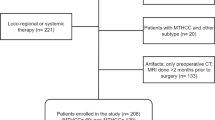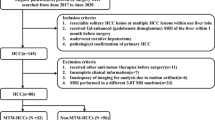Abstract
Purpose
To evaluate the efficacy of MRI-based radiomics and clinical models in predicting MTM-HCC. Additionally, to investigate the ability of the radiomics model designed for MTM-HCC identification in predicting disease-free survival (DFS) in patients with HCC.
Methods
A total of 336 patients who underwent oncological resection for HCC between June 2007 and March 2021 were included. 127 patients in Cohort1 were used for MTM-HCC identification, and 209 patients in Cohort2 for prognostic analyses. Radiomics analysis was performed using volumes of interest of HCC delineated on pre-operative MRI images. Radiomics and clinical models were developed using Random Forest algorithm in Cohort1 and a radiomics probability (RP) of MTM-HCC was obtained from the radiomics model. Based on the RP, patients in Cohort2 were divided into a RAD-MTM-HCC (RAD-M) group and a RAD-non-MTM-HCC (RAD-nM) group. Univariate and multivariate Cox regression analyses were employed to identify the independent predictors for DFS of patients in Cohort2. Kaplan–Meier curves were used to compare the DFS between different groups pf patients based on the predictors.
Results
The radiomics model for identifying MTM-HCC showed AUCs of 0.916 (95% CI: 0.858–0.960) and 0.833 (95% CI: 0.675–0.935), and the clinical model showed AUCs of 0.760 (95% CI: 0.669–0.836) and 0.704 (95% CI: 0.532–0.843) in the respective training and validation sets. Furthermore, the radiomics biomarker RP, portal or hepatic vein tumor thrombus, irregular rim-like arterial phase hyperenhancement (IRE) and AFP were independent predictors of DFS in patients with HCC. The DFS of RAD-nM group was significantly higher than that of the RAD-M group (p < .001).
Conclusion
MR-based clinical and radiomic models have the potential to accurately diagnose MTM-HCC. Moreover, the radiomics signature designed to identify MTM-HCC also can be used to predict prognosis in patients with HCC, realizing the diagnostic and prognostic aims at the same time.





Similar content being viewed by others
Abbreviations
- HCC:
-
Hepatocellular carcinoma
- MTM-HCC:
-
Macrotrabecular-massive hepatocellular carcinoma
- DFS:
-
Disease-free survival
- IRE:
-
Irregular rim-like arterial phase hyperenhancement
- WHO:
-
World health organization
- AFP:
-
Alpha-fetoprotein
- RFA:
-
Radiofrequency ablation
- TACE:
-
Transarterial chemoembolization
- VOI:
-
Volume of interest
- AP:
-
Arterial phase
- PVP:
-
Portal venous phase
- ICC:
-
Inter/intra-observer coefficients
- LASSO:
-
Least absolute shrinkage and selection operator
- RF:
-
Random forest
- RP:
-
Radiomics probability
References
Torbenson MS, Ng IOL, Park YN, Roncalli M, Sakamato M (2019) Hepatocellular carcinoma. WHO Classification of Tumours: Digestive System Tumour 229-239
Ziol M, Poté N, Amaddeo G et al (2018) Macrotrabecular-massive hepatocellular carcinoma: A distinctive histological subtype with clinical relevance. Hepatology 68:103-112
Boyault S, Rickman DS, de Reyniès A et al (2007) Transcriptome classification of HCC is related to gene alterations and to new therapeutic targets. Hepatology 45:42-52
Calderaro J, Couchy G, Imbeaud S et al (2017) Histological subtypes of hepatocellular carcinoma are related to gene mutations and molecular tumour classification. J Hepatol 67:727-738
Aggarwal A, Te HS, Verna EC, Desai AP (2021) A National Survey of Hepatocellular Carcinoma Surveillance Practices Following Liver Transplantation. Transplant Direct 7:e638
Lee S, Kang TW, Song KD et al (2021) Effect of Microvascular Invasion Risk on Early Recurrence of Hepatocellular Carcinoma After Surgery and Radiofrequency Ablation. Ann Surg 273:564-571
Zhang EL, Cheng Q, Huang ZY, Dong W (2021) Revisiting Surgical Strategies for Hepatocellular Carcinoma With Microvascular Invasion. Front Oncol 11:691354
Liu LL, Zhang SW, Chao X et al (2021) Coexpression of CMTM6 and PD-L1 as a predictor of poor prognosis in macrotrabecular-massive hepatocellular carcinoma. Cancer Immunol Immunother 70:417-429
Sherman M, Bruix J (2015) Biopsy for liver cancer: how to balance research needs with evidence-based clinical practice. Hepatology 61:433-436
Department of Medical Administration, National Health and Health Commission of the People’s Republic of China (2020) [Guidelines for diagnosis and treatment of primary liver cancer in China (2019 edition)]. Zhonghua Gan Zang Bing Za Zhi 28:112–128
European Association for the Study of the Liver, European Organisation for Research and Treatment of Cancer (2012) EASL-EORTC clinical practice guidelines: management of hepatocellular carcinoma. J Hepatol 56:908–943
Heimbach JK, Kulik LM, Finn RS et al (2018) AASLD guidelines for the treatment of hepatocellular carcinoma. Hepatology 67:358-380
Feng Z, Li H, Zhao H et al (2021) Preoperative CT for Characterization of Aggressive Macrotrabecular-Massive Subtype and Vessels That Encapsulate Tumor Clusters Pattern in Hepatocellular Carcinoma. Radiology 300:219-229
Rhee H, An C, Kim HY, Yoo JE, Park YN, Kim MJ (2019) Hepatocellular Carcinoma with Irregular Rim-Like Arterial Phase Hyperenhancement: More Aggressive Pathologic Features. Liver Cancer 8:24-40
Rhee H, Cho ES, Nahm JH et al (2021) Gadoxetic acid-enhanced MRI of macrotrabecular-massive hepatocellular carcinoma and its prognostic implications. J Hepatol 74:109-121
Zhu Y, Weng S, Li Y et al (2021) A radiomics nomogram based on contrast-enhanced MRI for preoperative prediction of macrotrabecular-massive hepatocellular carcinoma. Abdom Radiol (NY) 46:3139-3148
Cannella R, Dioguardi Burgio M, Beaufrère A et al (2021) Imaging features of histological subtypes of hepatocellular carcinoma: Implication for LI-RADS. JHEP Rep 3:100380
Yang L, Wang M, Zhu Y et al (2023) Corona enhancement combined with microvascular invasion for prognosis prediction of macrotrabecular-massive hepatocellular carcinoma subtype. Front Oncol 13:1138848
Gong Q, Zhang Y, Wu T, Du Z, Zhang Y (2023) Comparison of computed tomography and magnetic resonance imaging findings and histopathological features of macrotrabecular-massive hepatocellular carcinoma. Quant Imaging Med Surg 13:4633-4640
Zhang Y, He D, Liu J, Wei YG, Shi LL (2023) Preoperative prediction of macrotrabecular-massive hepatocellular carcinoma through dynamic contrast-enhanced magnetic resonance imaging-based radiomics. World J Gastroenterol 29:2001-2014
Bilal Masokano I, Pei Y, Chen J et al (2022) Development and validation of MRI-based model for the preoperative prediction of macrotrabecular hepatocellular carcinoma subtype. Insights Imaging 13:201
Hu S, Kang Y, Xie Y et al (2023) (18)F-FDG PET/CT-based radiomics nomogram for preoperative prediction of macrotrabecular-massive hepatocellular carcinoma: a two-center study. Abdom Radiol (NY) 48:532-542
Wei J, Jiang H, Zeng M et al (2021) Prediction of Microvascular Invasion in Hepatocellular Carcinoma via Deep Learning: A Multi-Center and Prospective Validation Study. Cancers (Basel) 13
Guarino M, Cucchetti A, Pontillo G et al (2021) Pattern of macrovascular invasion in hepatocellular carcinoma. Eur J Clin Invest 51:e13542
Yang T, Lu JH, Lau WY et al (2016) Perioperative blood transfusion does not influence recurrence-free and overall survivals after curative resection for hepatocellular carcinoma: A Propensity Score Matching Analysis. J Hepatol 64:583-593
van Griethuysen JJM, Fedorov A, Parmar C et al (2017) Computational Radiomics System to Decode the Radiographic Phenotype. Cancer Res 77:e104-e107
Huang W, Jiang Y, Xiong W et al (2022) Noninvasive imaging of the tumor immune microenvironment correlates with response to immunotherapy in gastric cancer. Nat Commun 13:5095
Fang JH, Zhou HC, Zhang C et al (2015) A novel vascular pattern promotes metastasis of hepatocellular carcinoma in an epithelial-mesenchymal transition-independent manner. Hepatology 62:452-465
Kawamura Y, Ikeda K, Seko Y et al (2011) Heterogeneous type 4 enhancement of hepatocellular carcinoma on dynamic CT is associated with tumor recurrence after radiofrequency ablation. AJR Am J Roentgenol 197:W665-673
An C, Kim DW, Park YN, Chung YE, Rhee H, Kim MJ (2015) Single Hepatocellular Carcinoma: Preoperative MR Imaging to Predict Early Recurrence after Curative Resection. Radiology 276:433-443
Kierans AS, Leonardou P, Hayashi P et al (2010) MRI findings of rapidly progressive hepatocellular carcinoma. Magn Reson Imaging 28:790-796
Mulé S, Galletto Pregliasco A, Tenenhaus A et al (2020) Multiphase Liver MRI for Identifying the Macrotrabecular-Massive Subtype of Hepatocellular Carcinoma. Radiology 295:562-571
Fraum TJ, Tsai R, Rohe E et al (2018) Differentiation of Hepatocellular Carcinoma from Other Hepatic Malignancies in Patients at Risk: Diagnostic Performance of the Liver Imaging Reporting and Data System Version 2014. Radiology 286:158-172
Funding
No funds, grants, or other support was received.
Author information
Authors and Affiliations
Contributions
All authors contributed to the study conception and design. Material preparation, data collection and analysis were performed by FC, YM, CF, XJ and JC. The first draft of the manuscript was written by FC and all authors commented on previous versions of the manuscript. All authors read and approved the final manuscript.
Corresponding author
Ethics declarations
Conflict of interest
The authors have no relevant financial or non-financial interests to disclose.
Ethical approval
This retrospective cohort study was approved by the Institutional Review Board of Peking University People’s Hospital.
Informed consent
The requirement for written informed consent was waived.
Additional information
Publisher's Note
Springer Nature remains neutral with regard to jurisdictional claims in published maps and institutional affiliations.
Supplementary Information
Below is the link to the electronic supplementary material.
Rights and permissions
Springer Nature or its licensor (e.g. a society or other partner) holds exclusive rights to this article under a publishing agreement with the author(s) or other rightsholder(s); author self-archiving of the accepted manuscript version of this article is solely governed by the terms of such publishing agreement and applicable law.
About this article
Cite this article
Chai, F., Ma, Y., Feng, C. et al. Prediction of macrotrabecular-massive hepatocellular carcinoma by using MR-based models and their prognostic implications. Abdom Radiol 49, 447–457 (2024). https://doi.org/10.1007/s00261-023-04121-7
Received:
Revised:
Accepted:
Published:
Issue Date:
DOI: https://doi.org/10.1007/s00261-023-04121-7




